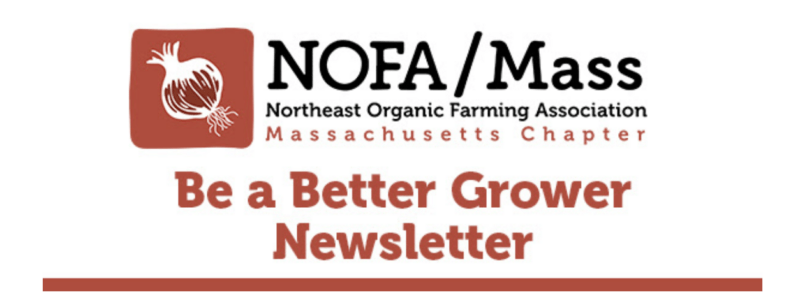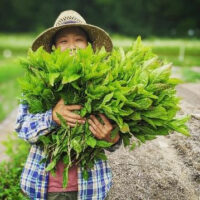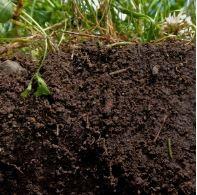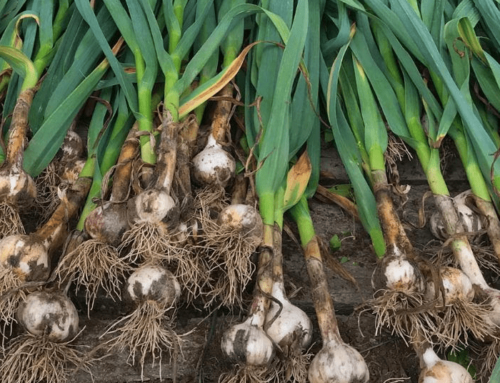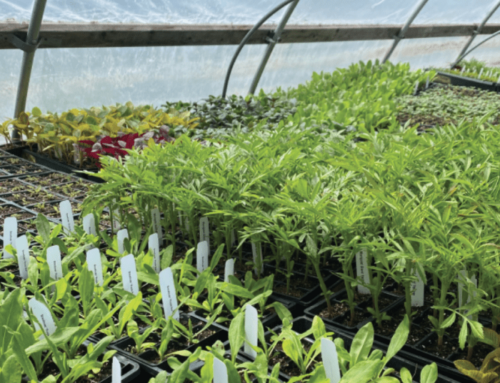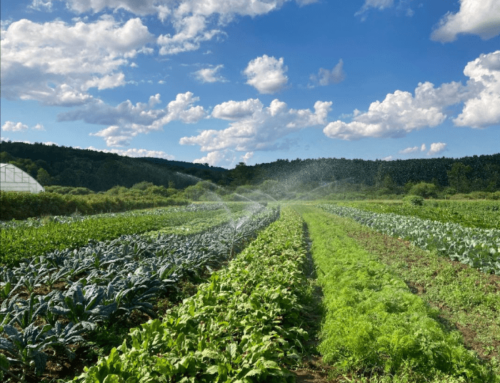By: Ruben Parrilla, NOFA/Mass Education and Technical Assistance Director
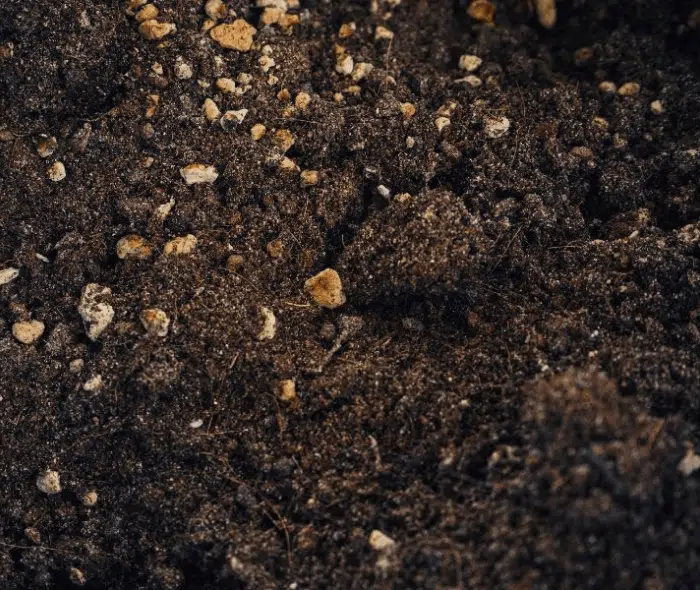
Welcome to the latest edition of the Northeast Organic Farming Association, Massachusetts Chapter (NOFA/Mass) Be a Better Grower newsletter. Established in 1982, NOFA/Mass is a dedicated and vibrant community of over 1,000 members encompassing farmers, gardeners, food systems activists, and individuals who share a common concern for the environment and our food system. Our mission is simple yet profound: Through education and advocacy, NOFA/Mass promotes organic agriculture to expand the production and availability of nutritious food from living soil, all in the pursuit of a healthier future for Massachusetts and beyond.
At NOFA/Mass, we envision a commonwealth of people working together to create healthy landscapes that feed our communities and restore our environment. This vision is not just a dream; it’s our collective commitment to sustainable and regenerative agriculture.
In this edition, we are thrilled to share insights into a transformative project made possible through the Sustainable Agriculture Research and Education (SARE) grant program. This grant focuses on farmer behavior change, a key requirement that aligns perfectly with NOFA/Mass’s mission. The grant supports projects that lead to measurable on-farm changes, ultimately enhancing sustainability within our farming and gardening communities.
The project highlighted in this newsletter delves into a not-so-common, yet highly impactful technique: the inoculation of finished compost with spent mushroom substrate. Thanks to the SARE grant, this innovative technique is being explored further, showcasing not only increased microbial biodiversity but also the remarkable use of what is typically considered a waste product. This dual focus enhances the sustainability of this project, demonstrating the potential to significantly benefit farmers, gardeners, and the environment alike.
While this marks the final round of this particular grant program, NOFA/Mass continues to offer a wealth of educational events, workshops, and initiatives that are closely related to the findings of this project. We aim to explore this technique with the community as it starts to implement these exciting developments.
Thank you for being a part of our community, supporting our mission, and sharing in our dedication to organic agriculture. In the pages that follow, you will discover more about this technique, its outcomes, and the positive changes it can bring to our farming and gardening practices.
Let’s embark on this journey together, with a commitment to the health of individuals, communities, and the planet through organic agriculture.
Inoculating Finished Compost with Spent Mushroom Substrate:
Explanation of the technique, its benefits, and its relevance to farmers, gardeners, and homesteaders
Before we begin it is important to make sure we are clear on what spent mushroom substrate (SMS) is in this context. Spent mushroom substrate (SMS) is the growth medium leftover after the fruiting bodies (mushrooms) of fungi have cycled through. In our case this material was mostly composed of sawdust and some grain. A flush, in mushroom cultivation, refers to the growing cycle of the mushroom; of note the SMS used for this project only went through one flush.
It’s crucial to note that in our methodology, we chose not to discriminate among the species of mushrooms used. The primary objective was not to identify the “best” species for optimal results but rather to adopt a holistic approach. The essence of this project lies in repurposing what is conventionally deemed a waste product from mushroom cultivation.
Inoculating finished compost with SMS bears significant potential benefits for both mushroom growers and gardeners/farmers alike. By not limiting ourselves to a specific mushroom species, we open doors for the mushroom farmer to explore various outlets for their SMS. Simultaneously, the gardener or farmer reaps the rewards of enhanced compost, experiencing a cascade of positive effects downstream. This symbiotic relationship contributes to the sustainable and efficient utilization of resources within the agricultural cycle.
In the following sections, we’ll explore the intricacies of this integration process and its implications for both mushroom growers and those tending to the soil. Together, we uncover a pathway toward more resourceful and environmentally conscious practices in mushroom cultivation and agriculture.
Step-by-step guide on how to employ this technique
The initial step involves ensuring you have finished compost. Finished compost has completed a thermophilic phase and is transitioning to the maturation phase where it stabilizes at a consistent temperature. This stability is crucial, especially when utilizing a static compost pile. During this project thermophilic compost was used exclusively; other composting methods were not explored. Heat generated during the composting process has the potential to denature some organisms, diminishing biodiversity. For this reason, it is imperative to use only finished compost.
Once finished compost has been acquired, obtain SMS blocks. Break down SMS black into the smallest possible size. This can be done by hand, using a shovel or a combination of both methods. Breaking down the SMS increases the surface area which consequently enhances the number of inoculation points in the compost. The incorporation process involves volume measurements, employing ratios of 10%, 25%, and 50% SMS to compost.
Use 5-gallon buckets to determine the volume of compost. Measure out the corresponding proportions of SMS to achieve the desired ratio of SMS to Compost. For instance, if you have measured out 9 (5)-gallon buckets of compost you must mix in 1 (5)-gallon bucket of SMS in order to achieve a 10% SMS to Compost ratio. Mix thoroughly; the compost is now considered inoculated.
To encourage microbial activity in the inoculated compost specific environmental conditions must be maintained. The pile is monitored for moisture, and it is shaded to create an optimal environment. In this study we used a relative moisture meter that was calibrated to field capacity once the substrate was mixed. The way to calibrate the meter is to first determine if the pile has sufficient moisture. This is done by tightly squeezing a fist full of inoculated compost. If one or two drops come out of your fist this would be considered optimal. The moisture can then be monitored with a meter every other day for the next two weeks. In addition, the pile was not turned and allowed to rest in this state as it was speculated that disturbance may affect mycelial growth by breaking the possible hyphal connections. An incubation period of two weeks under these conditions should be allowed to lapse before any analyses are conducted.
After the two-week incubation period the inoculated compost is ready for application in the field. Because each farm employs their own unique bed preparation technique the application process varies. However, we encourage you the reader to apply this inoculated compost using whatever technique you currently employ, the key to this process is to incorporate these methods into existing practices.
In the subsequent sections, we will unravel the significance of each phase in this process, shedding light on the considerations and outcomes that have emerged from our exploration.
Tips for successful implementation
This process is simple and should be very adaptable to anyone who uses compost. Here are a few things we learned through this process. We hope that you can learn from some of these tips but also keep an open mind when taking on this process as you may develop other processes that better fit your current practice.
- Keep in mind the time of year when performing this process. Spring and Fall are perhaps the best in our climate (temperate) as the height of the Summer may make it more difficult to control some of these conditions (temperature and humidity).
- The incubation period used was two weeks but depending on the environmental conditions this can be left to incubate for longer than two weeks to increase the potential of biodiversity in the compost pile. Look for macrofauna such as earthworms and mollusks as this can be an indicator of our microbial friends moving in.
- The process of breaking up the SMS was done by hand and this process would certainly benefit from a mechanized approach to save your hands and time. This is particularly true if you intend to use the compost for direct seeding which benefits from a uniform seed bed. Breaking up the SMS uniformly can prove to be difficult if done by hand. If you are applying this to a bed with transplants or side dressing, then the size of the SMS is not as important to the bed preparation. Do keep in mind the size of the SMS is important for increasing inoculation points as described above no matter how the inoculated compost is applied.
- Account for pH. One parameter monitored during this process was the pH of the inoculated compost. Lower pH values were found in inoculated compost after the incubation period. Certain crops may be sensitive to these lower pH values; be sure to monitor pH and proceed according to individual needs
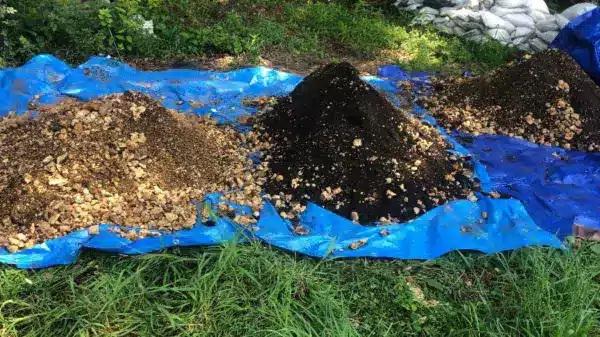
The Impact of Inoculation
In this section, we explore the fascinating interplay of soil biodiversity and its effects on our agricultural systems. By employing the technique of inoculating finished compost with SMS, we set the stage for a holistic transformation in our farming and gardening practices. While our project didn’t directly measure the outcomes of increased soil fertility and crop yields, it can be reasonably implied that crops benefit from the following favorable outcomes when compost enhanced with biodiversity is applied.
Pest Resistance: A diverse microbial community in the soil plays a vital role in enhancing pest resistance in crops. Soil teeming with beneficial microorganisms acts as a natural defense system. These microorganisms can outcompete harmful pathogens, reducing the need for chemical pesticides. As we embrace the diversity of life in the soil, we pave the way for healthier, more robust plants that are less vulnerable to pests.
Nutrient Cycling: Soil biodiversity is at the heart of efficient nutrient cycling. Microbes break down organic matter and recycle nutrients, making them available to plants. This nutrient cycling not only ensures that plants receive the essential elements they need for growth but also reduces nutrient leaching, minimizing environmental pollution. Inoculating compost with spent mushroom substrate adds to this intricate web of life in the soil, enhancing nutrient cycling and promoting a sustainable nutrient flow within the ecosystem.
Soil Structure: The structure of the soil is the physical foundation upon which microbial life thrives. Well-structured soil offers aeration and proper water infiltration, providing the necessary living conditions for microbes. The burrows and channels created by soil organisms, such as earthworms and microarthropods, enhance soil structure. As we focus on increasing soil biodiversity through inoculation, we indirectly contribute to improved soil structure. These physical changes in the soil create a habitat that fosters a more diverse and resilient microbial community, further enhancing nutrient availability and moisture retention.
The intricate relationships between soil biodiversity, pest resistance, nutrient cycling, and soil structure form a dynamic ecosystem, which supports our agricultural endeavors. Although our project didn’t measure these outcomes directly, the principles of regenerative agriculture strongly suggest that by nurturing the life within our soils, we are on the path to more sustainable and productive farming and gardening practices.
Impact of Inoculating Compost with SMS: A Microbial Symphony Unveiled
The relationships between soil biodiversity and soil health as described above are crucial and while those are general indicators, we would like to share some project specific organisms of interest and the role they play in soil ecology.
1. Nematodes: Champions of Nutrient Cycling
The most significant population surge observed post-inoculation was that of nematodes. These microscopic, worm-like organisms play a pivotal role in soil ecology, particularly in nutrient cycling. As the nematode population booms, so does their ability to regulate the microbial community. Nematodes actively graze on bacteria, fungi, and other microorganisms, creating a dynamic balance in the soil. This predation not only controls microbial populations but also facilitates the release of essential nutrients through the breakdown of organic matter. In this symbiotic dance, nematodes contribute to the enhancement of nutrient availability, fostering a healthier and more vibrant soil ecosystem.
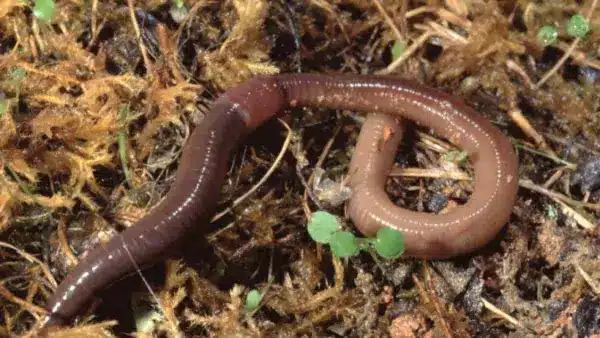
2. Trichoderma: The Beneficial Fungus
SMS, being prone to Trichoderma infection during mushroom cultivation, introduced a fascinating twist to the microbial landscape. Trichoderma, despite its potentially detrimental role in mushroom blocks, is an invaluable asset in agricultural soils. This fungus acts as a biocontrol agent, suppressing the growth of harmful pathogens. Its antagonistic nature makes it a natural ally against various soil-borne diseases. Furthermore, Trichoderma is renowned for its capacity to enhance plant growth by promoting root development and nutrient absorption. In the delicate balance of soil microbiota, Trichoderma emerges as a defender, contributing to the overall health and resilience of the agricultural ecosystem.
3. Snails: Architects of Soil Structure and Health
Among the observed organisms, snails played a distinctive role in shaping the physio-ecological functions of the soil. These gastropods contribute to soil health in multifaceted ways. Their movements aid in soil aeration and, in turn, promote a favorable environment for microbial life. As they graze on organic matter, snails assist in breaking down plant residues, facilitating the decomposition process. Moreover, their excretions add valuable organic material to the soil, enriching its nutrient content. In this intricate web of interactions, snails emerge as architects of soil structure, contributing to a well-balanced and thriving soil ecosystem.
4. Earthworms: Soil Engineers and Nutrient Cyclers
The inoculation of compost with SMS also triggered a notable increase in earthworm populations. Earthworms, often referred to as soil engineers, play a fundamental role in soil structure and nutrient cycling. Their burrowing activities create channels that enhance soil aeration and water infiltration. Earthworm castings, a byproduct of their feeding and burrowing, are nutrient-rich and contribute to the improvement of soil fertility. Earthworms promote healthy and well-structured soil environment conducive to microbial life and plant growth by tilling the soil.
In essence, the inoculation of compost with SMS orchestrates a diverse ensemble of soil-dwelling organisms, each playing a unique and vital role in promoting nutrient cycling, disease resistance, and overall soil health. This holistic perspective underscores the intricate connections within the soil ecosystem, showcasing the collaborative efforts of nematodes, Trichoderma, snails, and earthworms to name a few in fostering resilient and thriving soils.
Now, more than ever, we invite you to be an active participant in the transformation of agricultural landscapes. Inspired by the innovative technique explored in this edition, we encourage farmers, gardeners, and advocates to embrace the symbiotic relationship between organic agriculture and sustainable practices. Consider incorporating the inoculation of finished compost with spent mushroom substrate into your methods, exploring the potential for increased microbial biodiversity and the repurposing of waste products. Join us at NOFA/Mass in this journey towards regenerative agriculture by attending our educational events, workshops, and initiatives that delve into these groundbreaking findings. Let’s collectively shape a future where our soils thrive, communities flourish, and the agricultural cycle becomes a harmonious dance with nature. Your involvement is not just a choice; it’s a step towards a healthier, more vibrant tomorrow. Together, let’s cultivate a sustainable legacy that echoes through the fields, gardens, and landscapes of Massachusetts and beyond.
As we conclude this newsletter, we extend our gratitude to our community for being part of this journey, supporting our mission, and sharing in our dedication to organic agriculture. While this marks the final round of the highlighted grant program, NOFA/Mass remains a hub of educational events, workshops, and initiatives closely tied to the project’s findings. We are committed to exploring this innovative technique with the community as it begins to implement these exciting developments.
Thank you for joining us in this collaborative endeavor to cultivate a sustainable tomorrow. The pages you’ve explored contain insights into a technique that goes beyond agriculture—it’s a testament to the resilience of nature and the potential for regenerative practices. Together, let’s continue nurturing our soils, fostering vibrant communities, and building a healthier, more sustainable future.

